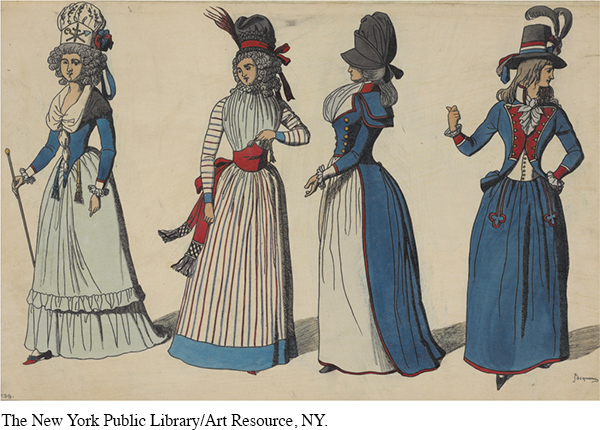France and Britain
While Indian battles engaged the American military in the west, another war overseas to the east was also closely watched. In 1789, monarchy came under attack in France, bringing on a revolution whose democratic ideals inspired Americans in many states to celebrate the victory of the French people. Dozens of pro-French political clubs, called Democratic or Republican Societies, sprang up around the country. Even fashions expressed symbolic solidarity, causing some American women to don sashes and cockades made with ribbons of the French Revolution’s red, white, and blue colors. Pro-French headgear for committed women included an elaborate turban, leading one horrified Federalist newspaper editor to chastise the “fiery frenchified dames” thronging Philadelphia’s streets. In Charleston, South Carolina, a pro-French pageant in 1793 united two women as partners, one representing France and the other America. The women repudiated their husbands “on account of ill treatment” and “conceived the design of living together in the strictest union and friendship.” Most likely, this ceremony was not the country’s first same-sex marriage but instead a richly metaphorical piece of street theater in which the spurned husbands represented the French and British monarchs. In addition to these symbolic actions, the growing exchange of political and intellectual ideas across the Atlantic helped plant the seeds of a woman’s rights movement in America. [[LP Photo: P09.06 Revolutionary Solidarity /

Anti–French Revolution sentiments also ran deep. Vice President John Adams, who lived in France in the 1780s, trembled to think of radicals in France or America. “Too many Frenchmen, after the example of too many Americans, pant for the equality of persons and property,” Adams said. “The impracticability of this, God Almighty has decreed, and the advocates for liberty, who attempt it, will surely suffer for it.”
Support for the French Revolution remained a matter of personal conviction until 1793, when Britain and France went to war and divided loyalties now framed critical foreign policy debates. Pro-French Americans remembered France’s critical help during the American Revolution and wanted to offer aid now. But those shaken by the report of the guillotining of thousands of French people—including the monarch—as well as those with strong commercial ties to Britain sought ways to stay neutral.
In May 1793, President Washington issued the Neutrality Proclamation, which contained friendly assurances to both sides, in an effort to stay out of European wars. Yet American ships continued to trade between the French West Indies and France. In early 1794, the British expressed their displeasure by capturing more than three hundred of these vessels near the West Indies. Clearly, the president thought, something had to be done to assert American power.
Washington tapped John Jay, the chief justice of the Supreme Court and a man of strong pro-British sentiments, to negotiate commercial relations in the British West Indies and secure compensation for the seized American ships. Jay was also directed to address southerners’ demands for reimbursement for the slaves evacuated by the British during the war as well as western settlers’ demands to end the British occupation of frontier forts and their continuing involvement in the northwest fur trade.
Jay returned from his diplomatic mission with a treaty that no one could love. First, the Jay Treaty completely failed to address the captured cargoes or the lost property in slaves. Second, it granted the British a lenient eighteen months to withdraw from the frontier forts. (Despite that leniency, this provision projecting the end of British presence in the Northwest disheartened the Indians negotiating the Treaty of Greenville in Ohio and loomed as a significant factor in their decision to make peace.) Finally, the treaty called for repayment with interest of the debts that some American planters still owed to British firms dating from the Revolutionary War. In exchange for such generous terms, Jay secured limited trading rights in the West Indies and agreement that some issues—boundary disputes with Canada and the damage and loss claims of shipowners—would be decided later by arbitration commissions.
When newspapers published the terms of the treaty, powerful opposition quickly emerged. Citizens’ petitions, newspaper editorials, and public gatherings mobilized public opinion from North to South to a degree not seen before in the early Republic. The debate raised the question of whether citizens could presume to instruct elected officials, or whether they had to accept the judgment of those officials and await the next election to register their displeasure. The negative reactions got ugly. In Massachusetts, disrespectful graffiti (“Damn John Jay!”) appeared on walls, and effigies of Jay along with copies of the treaty were ceremoniously burned in noisy street demonstrations. When the Senate passed the treaty in mid-1795 by a vote of 20 to 10, a bare minimum of the two-thirds majority required, and the president signed it, the anti-Treaty opposition among many ordinary citizens refused to evaporate.
The controversy continued well into 1796. Opponents of the Jay Treaty in the House of Representatives called for hearings on the matter, demanding that the president disclose secret diplomatic documents. Washington refused. The House lacked constitutional authority to vote on treaties, but it did have primary power over all spending bills. Anti–Jay Treaty congressmen hoped to hamstring the hated agreement by defunding its key provisions. In the end, the final vote on appropriations for the treaty passed, but only by a 3-vote margin.
The yearlong struggle over the Jay Treaty revealed an emerging and as yet uncharted role in politics for public opinion, voiced by an aroused citizenry and frequently managed and shaped by newspaper editors and local political clubs. It also brought to the fore a bitter division among elected politicians that emerged along the same lines as the Hamilton-Jefferson split on economic policy.
Understanding the American Promise 3ePrinted Page 241
Section Chronology